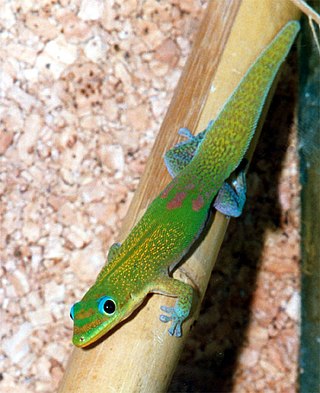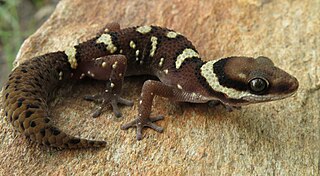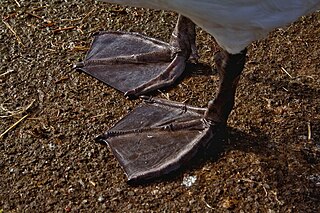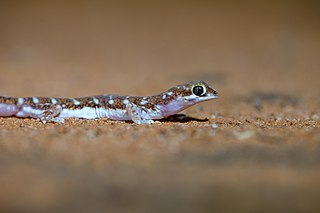
Geckos are small, mostly carnivorous lizards that have a wide distribution, found on every continent except Antarctica. Belonging to the infraorder Gekkota, geckos are found in warm climates throughout the world. They range from 1.6 to 60 centimetres.

Golden moles are small insectivorous burrowing mammals endemic to Sub-Saharan Africa. They comprise the family Chrysochloridae and as such they are taxonomically distinct from the true moles, family Talpidae, and other mole-like families, all of which, to various degrees, they resemble as a result of evolutionary convergence. There are 21 species. Some are relatively common, whereas others are rare and endangered.

Gekkonidae is the largest family of geckos, containing over 950 described species in 64 genera. The Gekkonidae contain many of the most widespread gecko species, including house geckos (Hemidactylus), the tokay gecko (Gekko), day geckos (Phelsuma), the mourning gecko (Lepidodactylus), and dtellas (Gehyra). Gekkonid geckos occur globally and are particularly diverse in tropical areas.

Pachydactylus is a genus of insectivorous geckos, lizards in the family Gekkonidae. The genus is endemic to Africa, and member species are commonly known as thick-toed geckos. The genus also displays rich speciation, having 58 distinct species identified when compared to other closely related gecko genera like Rhoptropus, most of which have emerged since 35Ma. It has been suggested that the reason for this rich speciation not from adaptive radiation nor nonadaptive radiation, but that the genus represents a clade somewhere between the two drivers of speciation. P. bibronii geckos have been used by NASA as animal models for experimentation.

Ptenopus is a small genus of lizards, known commonly as barking geckos, in the family Gekkonidae. The genus is endemic to southern Africa. There are only three described species in this genus.
The Namib brush-tailed gerbil or Setzer's hairy-footed gerbil is a species of rodent endemic to Angola and Namibia. Its natural habitats are sandy and gravelly plains. It stays in its burrow by day, emerging at night to feed on arthropods, vegetable matter, and seeds.
The dune hairy-footed gerbil, or the Namib dune gerbil is a species of rodent found only in Namibia. Its natural habitat is temperate desert where it lives in loose sand among sand dunes, feeding opportunistically on arthropods, seeds and green vegetation.

The desert rain frog, web-footed rain frog, or Boulenger's short-headed frog is a species of frog in the family Brevicipitidae. It is found in Namibia and South Africa. Its natural habitat is the narrow strip of sandy shores between the sea and the sand dunes. It is threatened by habitat loss by such factors as mining and tourism.
Pachydactylus austeni, also known commonly as Austen's thick-toed gecko or Austen's gecko, is a species of small thick-toed gecko, a lizard in the family Gekkonidae. The species is indigenous to the western coast of South Africa.

Seothyra, commonly known as the buckspoor spiders, buck spoor spiders or just spoor spiders, belong to a sand-dwelling, burrowing genus of araneomorph spiders in the family Eresidae. The 13 species are endemic to the arid, sandy flats and semistabilized red dunes of southern Africa. They are sexually dimorphic. The tiny males, which are seldom seen, imitate sugar ants or velvet ants in their appearance and habits, while the females hide in and hunt from their characteristic burrows. They are thermophilous, with males as well as females being most active on hot days.
The Namib day gecko is a species of lizard in the family Gekkonidae. The species is found in the deserts of Namibia and southern Angola. It is the type species of the genus Rhoptropus.

Paul Theodor Range was a German geologist and naturalist.

The webbed foot is a specialized limb with interdigital membranes (webbings) that aids in aquatic locomotion, present in a variety of tetrapod vertebrates. This adaptation is primarily found in semiaquatic species, and has convergently evolved many times across vertebrate taxa.

The border beaked gecko is a gecko endemic to Australia in the family Gekkonidae. It is known for its distinctive beak-like snout and ability to camouflage itself in its surroundings.
Pachydactylus acuminatus is a species of lizard in the family Gekkonidae, a family also known as the typical geckos. The species P. acuminatus is endemic to Namibia. It was once believed to be a subspecies of Weber's thick-toed gecko but was lifted to species status in 2006.
Pachydactylus griffini is a species of lizard in the family Gekkonidae. The species is endemic to Namibia.
Pachydactylus maraisi is a species of lizard in the family Gekkonidae. The species is endemic to Namibia.
Pachydactylus scherzi is a species of lizard in the family Gekkonidae. The species is native to Southern Africa.
The Namib desert gecko, also known commonly as the Kaoko web-footed gecko, is a species of lizard in the family Gekkonidae. The species is native to southern Africa.

Bradfield's Namib day gecko is a species of lizard in the family Gekkonidae. The species is endemic to Namibia. This species was first described in 1935 by the British-born, South African zoologist John Hewitt, who gave it the name Rhoptropus bradfieldi in honour of the South African naturalist and collector R.D. Bradfield (1882–1949).











